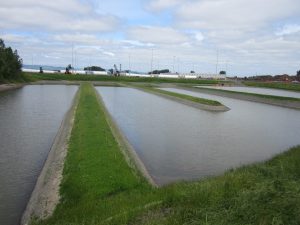Port of Vancouver USA Awarded $601,000 Grant for Improving Stormwater Treatment
 Today the Port of Vancouver USA announced that it had secured a $601,375 grant for enhancing its treatment systems for stormwater runoff.
Today the Port of Vancouver USA announced that it had secured a $601,375 grant for enhancing its treatment systems for stormwater runoff.
The grant is administered by the Washington State Department of Ecology through its Water Quality Combined Funding Program. The port will use the grant to design improvements to its stormwater systems that serve Terminals 2, 3 and 4 to treat runoff from roughly 268 acres of surface area. The port will specifically explore options to:
- Install pretreatment facilities for stormwater prior to its flow into an existing port-managed detention pond;
- Add a polishing system that would provide additional treatment to water exiting the pond before it flows into the Columbia River.
“We understand the importance of the port’s role in protecting the Columbia River and we constantly strive to make our operations more environmentally efficient,” said Julianna Marler, port CEO. “We’re pleased the Department of Ecology is financially partnering with us to make additional improvements to our stormwater treatment and safeguard this vital watershed.”
The port’s goal for the grant is to more efficiently remove dissolved metals like zinc and copper as well as diesel and oil from stormwater runoff. The port and Department of Ecology finalized the grant agreement earlier this month, which included the port’s commitment to match state dollars with $106,125 of its own funds.
Stormwater innovations at the Port of Vancouver USA
The Port of Vancouver USA seeks to build on multiple industry-leading programs it’s undertaken over the years designed to preserve and protect water quality. For instance, two members of its environmental team invented Grattix boxes for stormwater filtration – “rain garden in a box” – that can be easily assembled via the port’s information sharing and are now used at various sites around the world.
The port also found ways to construct floating treatment wetlands to reduce both contaminants in stormwater and costs. Read the story of this cost-efficient floating innovation here.
